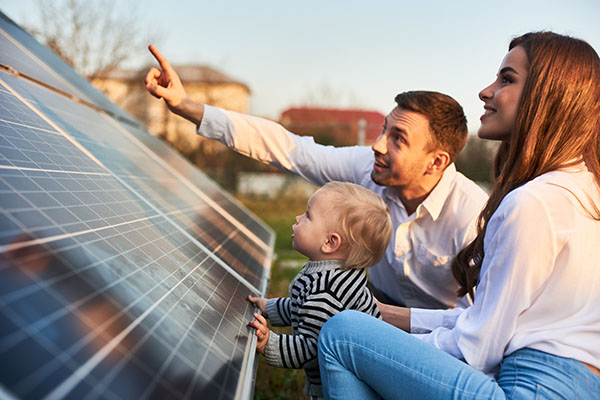Quick Facts About Renewable Energy and Smart Grid
There are signs that renewable energy is being harnessed throughout Ohio, whether it is large areas of wind turbines or solar panels, including some on roofs. Renewable energy is energy from sources that either don’t run out or are easily replenished, like the sun or wind. Consumers should understand these two renewable energy sources and what “smart grid” means.
Solar Power
Solar power is a renewable energy source using the sun to generate electricity. Solar panels collect the sun’s energy to convert it into electricity. The more sunlight that hits a solar panel, the more electricity it produces.
In Ohio
Ohio could have a bright future for solar power since it averages over 170 sunny days per year. In 2024, Ohio had an installed solar capacity of 3,666 megawatts—enough to power almost 463,857 homes.
Benefits and concerns
Solar power is a clean and renewable energy source. It allows for energy production at home which can lower electricity bills. Solar power can also help to reduce dependence on imported and domestic fossil fuels. Some issues remain, such as how to dispose of worn-out panels.
Residential systems
A residential solar power system can be expensive. A typical installed system can range in cost from $15,000 to $30,000. As demand increases, and financial incentives continue, solar power may be a realistic investment for many Ohioans, depending on how much sun the panels can get.
Be cautious of solar power companies selling overpriced or inferior products. It is recommended that consumers considering home solar do careful research and get competing bids. Contact several installers and always check with the utility before purchasing. Don’t rush into a decision because of high-pressure sales tactics. Understand the contract and ask questions. Know if it is a purchase or a lease, and what happens if panels need repair or don’t perform as promised.
Wind Power
Wind power uses turbines to capture the wind’s energy and converts it into electricity. Turbine blades spin when the wind blows and the blades turn a generator that produces electricity.
In Ohio
According to the American Clean Power Association, Ohio ranks 22nd for total megawatts (MW) of wind energy produced. As of August 2024, Ohio had an installed wind capacity of 3,775 MW.
Benefits and concerns
Wind power provides electricity without burning fuel to pollute the air. According to the Department of Energy, wind power prevents 329 million metric tons of carbon dioxide emissions annually – equal to the emissions of 71 million cars. Wind power critics say that turbines are an eye-sore, produce noise and may disrupt wildlife even though other electricity generation sources have similar negative impacts. Continuing research may help reduce these issues.
Wind and Solar Power’s Future
Most of the wind turbines in use today are on land. However, more offshore wind sites are being built. The first offshore wind farm was built off the coast of Rhode Island in 2016. Wind turbines may be coming to Lake Erie in the not-too-distant future. The US Department of Energy’s Wind Vision Study indicates that wind energy could provide 35 percent of the nation’s electricity by 2050.
Improved energy storage technology can help wind and sun’s ability to meet energy needs, even at night and on windless or cloudy days.
Renewable Energy Choice
Ohio consumers have the option to choose who provides their electricity. Some marketers and governmental aggregators may offer green energy options. Always compare prices when considering these offers. Consumers should avoid “greenwashing,” which is a deceptive marketing tactic that could under-deliver green energy and over-charge them. Learn more from OCC’s Fact Sheet: How to Make Wise Energy Choices.
Smart Grid
The smart grid is a modern electrical network that uses digital technology to improve efficiency and reliability. It has the potential to reduce power outages, improve energy efficiency, and integrate renewable energy sources. Ohio utilities can use the smart grid to charge consumers more and to make it easier to disconnect service, while consumers are not seeing all the benefits of smart grid.
The smart grid uses sensors and communication technology to monitor the flow of electricity in the grid. This information can be used to optimize operations and prevent problems. Smart meters are installed in homes and businesses as part of the smart grid. Consumers not wanting a smart meter can usually opt out for a fee and get a meter without the smart-meter communication systems. Check with your utility for details.
To download: Click the folder with a down arrow icon. To print: Click the printer icon in the top right of the display.
If you need multiple copies for an organization or group, please contact a member of our outreach team.

